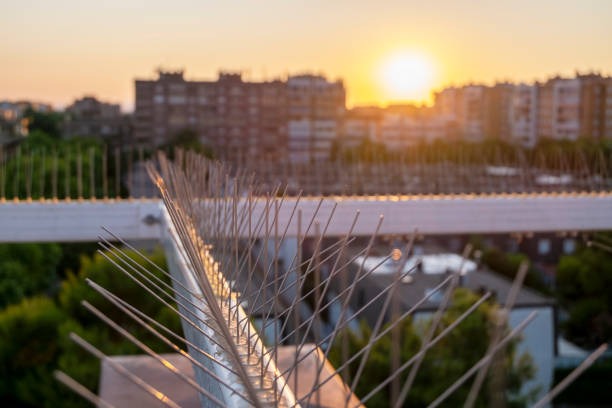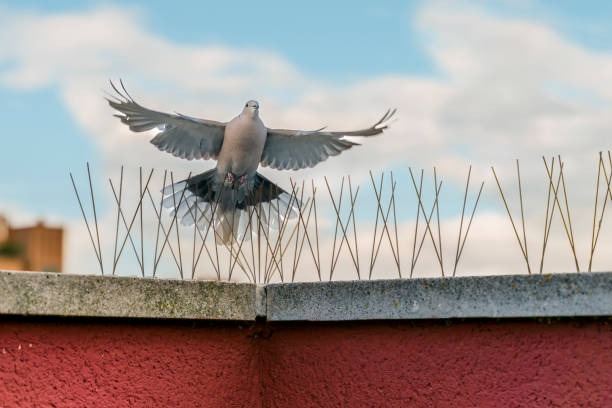Introduction:
Bird spikes are devices designed to deter birds from roosting, nesting, or perching on structures such as buildings, rooftops, ledges, and signs. They consist of rows of thin, pointed spikes that make it difficult or uncomfortable for birds to land or settle in these areas. The use of bird spikes has become a popular and effective method for addressing bird-related issues in various settings.
Why are bird spikes used?
1. Preventing roosting and nesting:

Birds are naturally attracted to perching and nesting on structures due to their elevated positions, providing safety and shelter. However, their presence can lead to various problems. Bird spikes act as a physical barrier that prevents birds from landing or settling on the protected areas, discouraging them from roosting or nesting. By eliminating potential roosting sites, bird spikes can help control bird populations and minimize associated issues such as noise, droppings, and debris.
2. Protecting property and structures:
Birds, particularly pigeons and seagulls, can cause damage to buildings and structures. They may dislodge roof tiles, block gutters and drains with nests and debris, or peck and scratch surfaces, leading to costly repairs and maintenance. Bird spikes serve as a deterrent, preventing birds from accessing these areas and reducing the risk of property damage. By eliminating the possibility of perching and roosting, bird spikes help protect structures and preserve their integrity.
3. Maintaining cleanliness and hygiene:
Bird droppings can be a significant issue in urban environments, posing health and sanitation concerns. Accumulated droppings not only create an unsightly appearance but can also carry diseases and contaminate surfaces. Bird spikes discourage birds from landing and defecating in protected areas, reducing the amount of droppings and maintaining cleaner and more hygienic surroundings.
Types and materials of bird spikes:
1. Different designs of bird spikes:
a. Single-row spikes: Consist of a single line of spikes, suitable for narrow ledges or surfaces.
b. Multi-row spikes: Have multiple parallel rows of spikes, ideal for broader areas and wider ledges.
2. Common materials used in bird spikes:
a. Stainless steel: Durable, weather-resistant, and long-lasting, stainless steel spikes are effective against most bird species.
b. Plastic or polycarbonate: Lightweight and cost-effective, these spikes are suitable for environments where aesthetics are a concern, such as historical buildings or architectural structures.
Installation and placement considerations:
1. Proper installation techniques:
a. Mounting options: Bird spikes can be installed using adhesive, screws, or wire ties, depending on the surface and intended permanence.
b. Ensuring stability and durability: Proper attachment and alignment of bird spikes are crucial to ensure stability and longevity.
2. Ideal locations for bird spikes:
a. Rooftops and ledges: Protecting rooftops, parapets, and ledges prevents birds from roosting or nesting in these areas.
b. Signage and outdoor structures: Installing bird spikes on signs, lighting fixtures, and other outdoor structures helps deter birds and maintain their functionality.
Environmental and ethical considerations:
1. Bird-friendly alternatives to bird spikes:
a. Bird netting: Can be used to create barriers, preventing birds from accessing specific areas without causing harm.
b. Visual deterrents: Reflective devices, predator replicas, or bird scare tactics can be employed to discourage birds from settling without physical barriers.
2. Ensuring humane treatment of birds:
It is essential to consider the well-being and welfare of birds while implementing bird control measures. Bird spikes should be installed correctly, ensuring that they do not cause injury to birds but only act as a deterrent.
Conclusion:
Bird spikes are effective tools for preventing roosting, nesting, and perching of birds on structures. They provide numerous benefits, including protecting property, preserving hygiene, and minimizing maintenance costs. By understanding the different types, materials, and installation considerations, one can effectively use bird spikes while considering environmental and ethical aspects.

